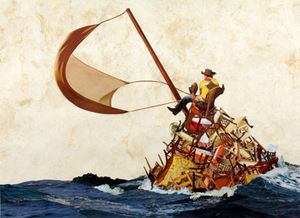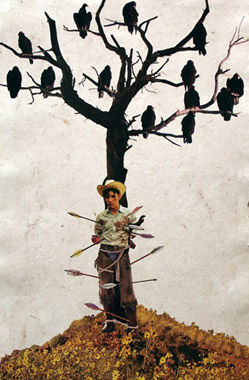This is an archive of the ArtCat Zine, 2007-2009. Please visit our new project, IDIOM.
The Absurd Hero: Javier Piñón, "Don Quixote And Other Stories"
Don Quixote and Other Stories
Javier Piñón
15 November - 22 December 2007
ZieherSmith - 531 W. 25, New York NY
I like collage. It's fast and economical, and paradoxical. It's about making things up by not making anything up. And, like Javier Piñón, I am from the southwest. So I grew up on all this Marlboro Man imagery and the rodeo, as well as a heavy dose of Catholicism. I can't go on without admitting that Piñón's work soothes me — it confirms and upholds some things I already know to be true. It's easier to write complete and rigorous thoughts when you're pushing at something new.
But Don Quixote And Other Stories is not about novelty. In fact, in some ways you've seen this show before. It's all smallish and tastefully framed. It's doing that surrealist collage thing that Hannah Höch explored thoroughly about 80 years ago and is now downright academic. And it's steeped in all sorts of things you may or may not already know — it's about references. It helps if you've already experienced the visual language of the actual southwest: its sweet and desperate patron saint candles and lonely roadsides, and the technicolor landscapes of old Arizona Highways and Sunset magazines. It is helpful to walk into this show knowing your mythology, your western films, your pop culture. It also helps if you've read Joseph Campbell.
What I like about this body of work is not that it breaks new ground or is the hot new thing. I like that it doesn't have to be. I like that Piñón works with all this existing material and strategy sensitively enough to point back at your own silly impulse towards novelty everywhere. I like that the work draws me in — not with gimmicks like hugeness, or paint on the floor, or making everyone take their shoes off or wear 3-D glasses — but by overcoming its own limitations of size, structure and genre.
The imagery in Don Quixote And Other Stories is surreal. And surrealism is a lot like science fiction. It's one of those genres that invites disaster because it's about making up a world. It's so easy for artists and authors to get caught up in explaining the logic of the little world they are creating, and wind up doing nothing interesting with it. Piñón avoids this. He wastes no time on explaining the relationship between cowboys and Don Quixote, or knights, or Odysseus, and lets the relationships emerge.
Collage makes this purposeful senselessness easier and more difficult at the same time. On one hand, we all know that collage is instantly satisfying because it quickly allows silly juxtapositions that have the potential to be exponentially meaningful because they are taken from a specific place. What better insurance policy does an artist have against explaining too much, or making too much sense? But you know, the very ease of throwing the medusa head into the hand of the cowboy invites easy irony or worse — reference soup. Piñón avoids this as well. What makes this work generous is its structural soundness. Each image is built upon a foundation a myth, saint, or story. And it is built up of references to whole thought-worlds — the landscape, the cowboy, the knight in shining armor — so it's stacking frames of reference on top of one another to create a very specific meaning. But each frame of reference is being used for its visual value, and not just its smartypants backstory. I just wrote that it helps if you walk into this show knowing things, and it’s true. But it never becomes a pop quiz. Viewing this show may present you with an opportunity to spout like you're in a Woody Allen movie about that incredible painting by Mantegna, or what Thomas Mann wrote in Death In Venice, but you don't ever need to. Instead, you can just see that Saint Sebastian was riddled with arrows, and had the great misfortune not to die, and that this suffering is beautiful, because it's right there in the picture. I know it seems obvious, but that consistent follow-through makes for a set of images that is very rich and at the same time delightfully bereft of irony, in-jokes, and other intellectual fat.Don Quixote And Other Stories is deft and powerful in its little frames. And it achieves that power because Piñón is consistently focused, not on art history or his interest in mythology, but on a specific and timeless existential paradox that he is working to expand. There is an aspiring hero within every man, and each potential hero can shroud himself in any number of myths that promise to strengthen, guide, and protect him. But there is a deep loneliness and absurdity to the hero's pursuit that goes way beyond tilting at windmills.
ZINE
HOME
TIPS / COMMENTS
CATEGORIES
CONTRIBUTORS
- Greg Afinogenov
- B. Blagojevic
- Adda Birnir
- Susannah Edelbaum
- Julie Fishkin
- Paddy Johnson
- Jessica Loudis
- Christopher Reiger
- Andrew Robinson
- Peter J. Russo
- Blythe Sheldon
- S.C.Squibb
- Hrag Vartanian


